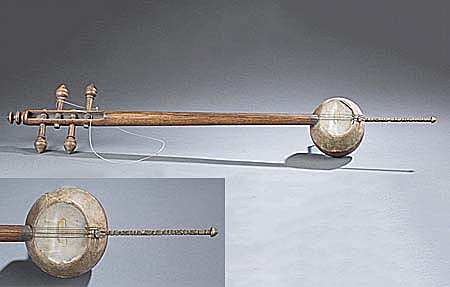
Owner: HWMC
Catalog#: 2ME-CHLT-01
Lutes
Iraq ‘Joze’ (Kamanja)
Iraq
Iraqian
Coconut, wood, steel strings, fish skin
Early – Mid 20th century
Length: 30 in; Diameter: 4 in; Depth: 3.25 in
Chordophones – Lutes
In Arabic, kamanja is the name of the violin, but this instrument is called joze. Joze in Arabic means coconut and the sound box of this instrument is made from a coconut shell. It is open on both sides with one side covered with a glued on fish skin, that is found in Iraq. This joze has four strings (traditionally tuned in perfect 4ths), that are attached to the tuning pegs in an open pegbox at the top. The strings pass over a floating bridge (ghazala) on the fish skin head and are attached to a metal plate that is part of the post/spike at the bottom. The post/spike that is attached to the wooden neck, passes through the coconut shell and serves as an extended type of foot.
The joze is used in a tradition called the Iraqi Maqam, a musical tradition that is exclusively used in Iraq. While the Iraqi Maqam is a vocal tradition and is sometimes performed ‘a cappella’ (no instrumental accompaniment), the joze, santur (dulcimer), daf (tambourine) and doumbek (goblet drum) are sometimes used to accompany the maqam singer. This traditional instrumental group is called chalghi baghdadi.
Resource: ‘Joze’, Scheherazade Qassim Hassan, “The Grove Dictionary of Musical Instruments,” 2nd ed, Vol 3. Laurence Libin, Editor in Chief. Oxford University Press.
